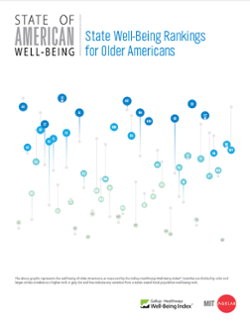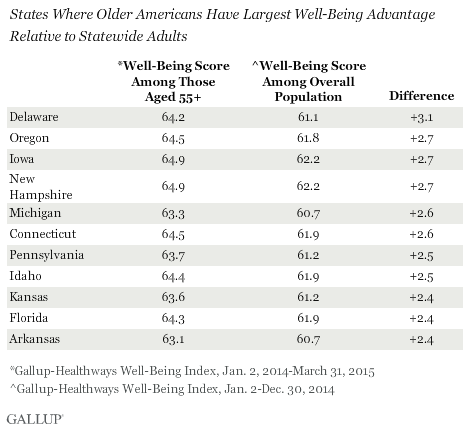Seniors Better Off Than Other Adults in CT; State’s Ranks #6 in Senior Advantage
/Older adults living in Delaware have the largest well-being advantage relative to the overall state population, followed closely by Oregon, Iowa, New Hampshire, Michigan and Connecticut. A new state-by-state comparison examines the comparative well-being of Americans age 55 and older, and reveals that, nationally, people in that age category have higher well-being than the rest of the population. The inaugural report is based on data from the Gallup-Healthways Well-Being Index®.
The growing percentage of the American population over the age of 55 — a trend largely driven by the Baby Boomers entering later life — has important implications for a variety of stakeholders, including families, employers, healthcare providers and policymakers, according to the report’s authors. “State Well-Being Rankings for Older Americans” aims to fill the research gap.
The report focuses on five elements of well-being: purpose, social, financial, community and physical. These five elements, according to Gallup and Healthways, create a composite picture of the well-being of older Americans in each state.  The Well-Being Index is calculated on a scale of zero to 100, where zero represents the lowest possible well-being and 100 represents the highest possible well-being. Connecticut’s well-being score was 64.5 for those age 55+, compared with 61.9 for the overall adult population. The difference of 2.6 was the sixth highest among the states.
The Well-Being Index is calculated on a scale of zero to 100, where zero represents the lowest possible well-being and 100 represents the highest possible well-being. Connecticut’s well-being score was 64.5 for those age 55+, compared with 61.9 for the overall adult population. The difference of 2.6 was the sixth highest among the states.
The state where older Americans' well-being advantage is smallest is Wyoming, followed by Alaska, Oklahoma, Nevada, South Dakota, Maine and Vermont.
In an absolute sense, Hawaii, Montana, South Dakota, Alaska and Iowa are the top five states for overall well-being for older Americans -- states that also have high well-being rankings for the overall population. The next five: New Hampshire, Utah, Oregon, New Mexico and Connecticut.
That places Connecticut in the top 10 in the overall rankings for well-being for older residents, and for the well-being advantage its seniors have above the overall adult population in the state. Connecticut has the 7th oldest population in the nation. 
States with the lowest well-being for older Americans are also those where well-being as a whole tends to lag behind the rest of the country: West Virginia, Kentucky and Oklahoma. . The report is based on self-reported data from 114,388 interviews with individuals age 55 and older, and was conducted in conjunction with the Massachusetts Institute of Technology (MIT) AgeLab.
“The greatest success of humankind is longer life. The challenge today for families and society is how to live longer, better with the highest state of well-being,” said Joseph F. Coughlin, director and founder of the MIT AgeLab. “Understanding our aging population, including Baby Boomers, the largest generation in our nation’s history, will be critical as we design policies and interventions to help older Americans thrive in all aspects of their lives.”



 The Bridgeport-Stamford-Norwalk region ranked #5 in physical health, #43 in financial health, #58 in community ties, #63 in sense of purpose and #88 in social health.
The Bridgeport-Stamford-Norwalk region ranked #5 in physical health, #43 in financial health, #58 in community ties, #63 in sense of purpose and #88 in social health.



























